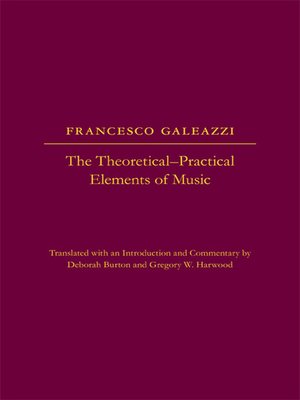The the Theoretical-Practical Elements of Music, Parts III and IV
ebook ∣ Studies in the History of Music Theory and Literature
By Francesco Galeazzi

Sign up to save your library
With an OverDrive account, you can save your favorite libraries for at-a-glance information about availability. Find out more about OverDrive accounts.
Find this title in Libby, the library reading app by OverDrive.



Search for a digital library with this title
Title found at these libraries:
| Library Name | Distance |
|---|---|
| Loading... |
A virtuoso violinist, conductor, composer, and a professor of mathematics and botany, Francesco Galeazzi (1758–1819) firmly believed that musical education should be clear, demonstrable, and practical. In 1791 and 1796, he published the two volumes of his Elementi teorico-practici di musica, a treatise that demonstrated both his thorough grounding in the work of earlier theorists and his own approach to musical study. The first volume gave precise instructions on the violin and how to play it; the second demonstrated his command of other instruments and genres and provided comprehensive introductions to music theory, music history, and music aesthetics. The treatise also addresses the nature of compositional process and eighteenth-century concerns about natural and acquired talent and creativity.
This volume offers an unprecedented English translation of the second volume of Elementi teorico-practici di musica, with annotations and commentary. The translation is introduced with a study of Galeazzi's life and milieu, the genesis and sources for the Elementi, and its reception through the present day.
| Title Page Copyright Page Contents Preface Part I: The Life of Francesco Galezaai Part II: The Theoretical-Practical Elements of Music Appendix: Writings and Compositions by Francesco Galeazzi Theoretical-Practical Elements of Music Preface Article I: Principles of Ancient and Modern Music Article II: Greek Music Theory Article III: Diatonic Genus Article IV: Chromatic and Enharmonic Genera Article V: Guido d'Arezzo Article VI: Notation and Clefs Article VII: Note Shapes and Mensuration Article VIII: Accidentals Article IX: Solfege Article X: Plainsong Modes Article XI: Keys Appendix: Part I, Article XI: Keys Article I: Intervals and Inversions Article II: Physical Harmonic Phenomenon Article III: Consonant and Dissonant Intervals Article IV: Fundamental Bass Article V: Cadences Article VI: Chord Inversions Article VII: Ascending Scale and Harmonic Connection Article VIII: Descending Scale Article IX: Compositional Styles Article X: Musical Motions and Strict Counterpoint Article XI: One or Two Notes against One Article XII: Four Notes against One Article XIII: Suspensions Article XIV: Florid Counterpoint Article XV: Harmony in Minor Keys Article XVI: Florid Counterpoint with Modulations Article XVII: Imitation Article XVIII: Three Parts Article XIX: Four Parts and Text Setting Article XX: Double Counterpoint Article XXI: Canon Article XXII: Fugue Article I: Writing Music Article II: Facilitating Inspiration Article III: Melody and Its Members Article IV: Modulation Article V: Pure Vocal Style Article VI: Pure Instrumental Style Article VII: Mixed Style and Orchestration Article VIII: Scores and Instruments Works Cited Index |Deborah Burton is an assistant professor of music theory at Boston University. Gregory W. Harwood is a professor of music at Georgia Southern University.
This volume offers an unprecedented English translation of the second volume of Elementi teorico-practici di musica, with annotations and commentary. The translation is introduced with a study of Galeazzi's life and milieu, the genesis and sources for the Elementi, and its reception through the present day.
| Title Page Copyright Page Contents Preface Part I: The Life of Francesco Galezaai Part II: The Theoretical-Practical Elements of Music Appendix: Writings and Compositions by Francesco Galeazzi Theoretical-Practical Elements of Music Preface Article I: Principles of Ancient and Modern Music Article II: Greek Music Theory Article III: Diatonic Genus Article IV: Chromatic and Enharmonic Genera Article V: Guido d'Arezzo Article VI: Notation and Clefs Article VII: Note Shapes and Mensuration Article VIII: Accidentals Article IX: Solfege Article X: Plainsong Modes Article XI: Keys Appendix: Part I, Article XI: Keys Article I: Intervals and Inversions Article II: Physical Harmonic Phenomenon Article III: Consonant and Dissonant Intervals Article IV: Fundamental Bass Article V: Cadences Article VI: Chord Inversions Article VII: Ascending Scale and Harmonic Connection Article VIII: Descending Scale Article IX: Compositional Styles Article X: Musical Motions and Strict Counterpoint Article XI: One or Two Notes against One Article XII: Four Notes against One Article XIII: Suspensions Article XIV: Florid Counterpoint Article XV: Harmony in Minor Keys Article XVI: Florid Counterpoint with Modulations Article XVII: Imitation Article XVIII: Three Parts Article XIX: Four Parts and Text Setting Article XX: Double Counterpoint Article XXI: Canon Article XXII: Fugue Article I: Writing Music Article II: Facilitating Inspiration Article III: Melody and Its Members Article IV: Modulation Article V: Pure Vocal Style Article VI: Pure Instrumental Style Article VII: Mixed Style and Orchestration Article VIII: Scores and Instruments Works Cited Index |Deborah Burton is an assistant professor of music theory at Boston University. Gregory W. Harwood is a professor of music at Georgia Southern University.







